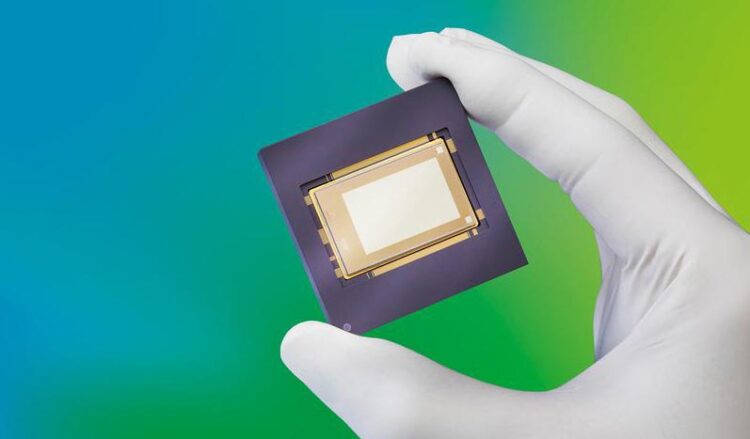Optical microsystems enable high-resolution fast light control

Spatial light modulators consisting of arrays of micromirrors on semiconductor chips
© Fraunhofer IPMS
Optical microsystems are forging the Path of Light: The photonic systems of Fraunhofer Institute for Photonic Microsystems IPMS can modulate light using small deflectable mirrors to create unique images and structures. Hereby the research institute is developing spatial light modulators with up to several million mirrors on a semiconductor chip. Main areas of application for mirror matrices are in the fields of microlithography in the deep ultraviolet range, production of printed circuit boards (PCBs), semiconductor inspection and metrology, as well as in adaptive optics, astronomy, holography and microscopy. With its developments in this field, Fraunhofer IPMS is currently a world leader.
The latest development of Fraunhofer IPMS is a CMOS-integrated micro mirror array with two tilting axes per mirror and associated technology platform.
In addition to its use in the semiconductor industry, the innovation enables novel methods of imaging in microscopy, especially for biomedical applications. The latter are realized in cooperation with the “Fraunhofer center for Microelectronic and Optical Systems for Biomedicine” MEOS within the Fraunhofer IPMS.
At the 25th world’s leading trade fair for photonics components, systems and applications – LASER – World of PHOTONICS – in Munich from April 26 to 29, visitors can find out about the latest developments at Fraunhofer IPMS. “One of our exhibits is the 2-axis tilting mirror demonstrator, which can be applied in optical beam steering, among other applications. In general, the micro mirrors of the IPMS spatial light modulators are individually tilted or deflected vertically, depending on the application, so that optical patterns are projected and thereby for example surface structures are formed,” explains Dr. Michael Wagner, head of the Spatial Light Modulators (SLM) business unit at Fraunhofer IPMS. “Using the tilting mirror macromodels, visitors can also move the micro mirrors of the spatial light modulators themselves using a large model and gain an impression of the deflection functionalities that are possible,” continues Dr. Wagner.
The Fraunhofer IPMS exhibition booth is located at booth #B4.239.
About Fraunhofer IPMS
The Fraunhofer Institute for Photonic Microsystems IPMS stands for applied research and development in the fields of industrial manufacturing, medical technology and improved quality of life. Our research focuses on miniaturized sensors and actuators, integrated circuits, wireless and wired data communication, and customized MEMS systems.
Media Contact
All latest news from the category: Physics and Astronomy
This area deals with the fundamental laws and building blocks of nature and how they interact, the properties and the behavior of matter, and research into space and time and their structures.
innovations-report provides in-depth reports and articles on subjects such as astrophysics, laser technologies, nuclear, quantum, particle and solid-state physics, nanotechnologies, planetary research and findings (Mars, Venus) and developments related to the Hubble Telescope.
Newest articles

Sea slugs inspire highly stretchable biomedical sensor
USC Viterbi School of Engineering researcher Hangbo Zhao presents findings on highly stretchable and customizable microneedles for application in fields including neuroscience, tissue engineering, and wearable bioelectronics. The revolution in…

Twisting and binding matter waves with photons in a cavity
Precisely measuring the energy states of individual atoms has been a historical challenge for physicists due to atomic recoil. When an atom interacts with a photon, the atom “recoils” in…

Nanotubes, nanoparticles, and antibodies detect tiny amounts of fentanyl
New sensor is six orders of magnitude more sensitive than the next best thing. A research team at Pitt led by Alexander Star, a chemistry professor in the Kenneth P. Dietrich…





















